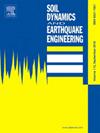Three-component composite columns periodically buried in elastic half space as metasurfaces for broadband surface-wave attenuation
IF 4.2
2区 工程技术
Q1 ENGINEERING, GEOLOGICAL
引用次数: 0
Abstract
Elastic metamaterials/metasurfaces have enabled many applications for vibration reduction in civil engineering in the past decade. This paper investigates the feasibility of harnessing novel three-component composite columns for surface-wave attenuation. The composite columns are periodically buried near the surface of an elastic half space to form a metasurface. Eigenvalue studies are conducted based on both the and methods, and broadband surface-wave bandgaps (SWBGs) are found in real and complex band structures. For the metasurface composed of concrete-rubber-steel composite columns, a broadband SWBG covering 36.5–96.9 Hz can be achieved with a small periodic constant of 0.3 m. The formation of the broadband SWBG is attributed to the local resonance mechanism, whose lower bound frequency is determined by the resonance of the core and upper bound frequency is mainly determined by the torsional resonance of the soft coating layer. Using complex band structures and frequency-domain simulations, the lack of correlation between the minimum imaginary parts of wave numbers and vibration reduction performance is well explained. In addition, it is found that the evanescent surface eigenmodes in the SWBG can be excited and observed in numerical simulations, indicating the complex band structure analysis is effective for understanding how surface waves decay in SWBGs. A comprehensive parametric study is performed to investigate the influence of geometric parameters, material parameters, and damping in material on the attenuation performance of the metasurface. The feasibility of applying the metasurface to mitigate train-induced ambient vibration is investigated via time-domain numerical simulations.
求助全文
约1分钟内获得全文
求助全文
来源期刊

Soil Dynamics and Earthquake Engineering
工程技术-地球科学综合
CiteScore
7.50
自引率
15.00%
发文量
446
审稿时长
8 months
期刊介绍:
The journal aims to encourage and enhance the role of mechanics and other disciplines as they relate to earthquake engineering by providing opportunities for the publication of the work of applied mathematicians, engineers and other applied scientists involved in solving problems closely related to the field of earthquake engineering and geotechnical earthquake engineering.
Emphasis is placed on new concepts and techniques, but case histories will also be published if they enhance the presentation and understanding of new technical concepts.
 求助内容:
求助内容: 应助结果提醒方式:
应助结果提醒方式:


